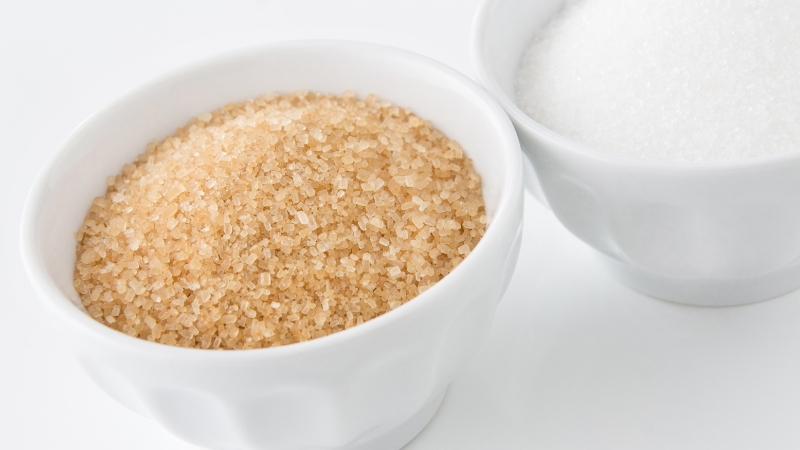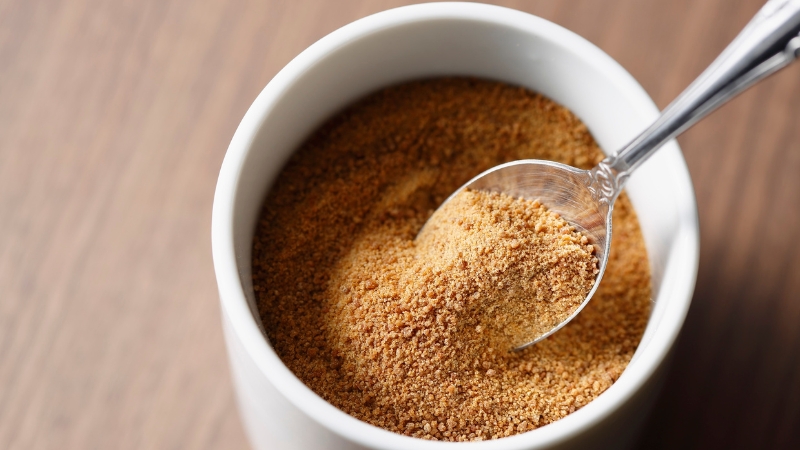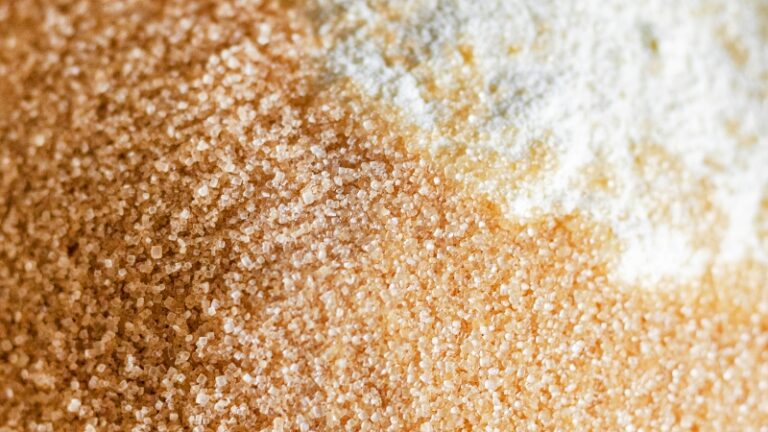Alright, let’s skip the sugar-coating (pun intended). People often swap out white sugar for maple sugar, thinking it’s the healthier choice.
But is it really? On the surface, maple sugar sounds better: it’s natural, straight from tree sap, with some minerals and antioxidants.
White sugar, by contrast, is refined and stripped of any nutrients. But here’s the truth — maple sugar is still sugar.
The nutritional perks are minimal unless you’re eating spoonfuls, which, let’s be real, isn’t the plan. So, let’s break down what you’re actually getting from both and figure out if maple sugar really earns its “healthier” label.
Comparison Table
First things first — let’s clear up what we’re talking about. So far, maple sugar sounds a bit more wholesome. But let’s see how they stack up nutritionally. Now, you might look at that table and think, “Okay, maple sugar has some nutrients, but the differences aren’t huge, right?” Exactly. The minerals and vitamins maple sugar brings to the table — calcium, manganese, riboflavin — are worth noting, but unless you’re eating large amounts (which we wouldn’t recommend!), It’s not a nutritional powerhouse. That said, those trace minerals do offer a little extra if you’re going to use a sweetener anyway. The manganese in maple sugar, for example, supports bone health and metabolic function. Riboflavin helps with energy production. And that lower glycemic index? It means maple sugar won’t spike blood sugar quite as quickly as white sugar does.
Feature
Maple Sugar
White Sugar
Source
Maple tree sap, boiled down
Sugarcane or sugar beets, heavily refined
Processing Level
Minimal
Extensive
Nutrients
Contains minerals & antioxidants
Lacks nutrients
Glycemic Index
Lower (54)
Higher (65)
Taste
Rich, caramel, earthy
Neutral, sweet
Versatility
Great for baking with flavor
Neutral, universal
Cost & Availability
Higher, less available
Cheaper, widely available
Health Impact
Slightly better if used sparingly
Neutral or negative if overused
Maple Sugar vs. White Sugar: What Are We Really Comparing?

Nutritional Breakdown
Nutrient
20g Maple Sugar
20g White Sugar
Calories
~69
~77
Total Carbohydrates
~17.8g
~20g
Sugar Content
~16.1g
~20g
Fat
0g
0g
Fiber
Trace
0g
Protein
Trace
0g
Calcium
~27mg
~0.2mg
Manganese
~0.54mg
0mg
Riboflavin (B2)
~0.34mg
0mg
Glycemic Index (GI)
~54
~65
Health Benefits
Alright, let’s get real. Is maple sugar truly healthier than white sugar? Short answer: it offers a few perks, but it’s still sugar, so the benefits are limited if we’re not careful.
What Maple Sugar Has Going For It
- Natural Source: Maple sugar is simply 100% pure maple syrup boiled down until it crystallizes. No refining, no additives, no bleaching. It retains the natural flavor and compounds from maple sap, unlike white sugar, which comes from sugarcane or sugar beets processed until it’s just pure sucrose.
- Trace Minerals & Phytochemicals: Maple sugar carries small amounts of nutrients like manganese, calcium, potassium, and riboflavin. It also contains over 50 polyphenols (plant compounds), including quebecol, which forms during boiling and may have antioxidant and anti-inflammatory properties. But let’s be honest — the amounts per serving are tiny. You’re not getting a day’s worth of minerals from a spoonful of maple sugar.
- Lower Glycemic Index: Maple sugar’s glycemic index (GI) is around 54, which is lower than white sugar’s GI of around 65. That means it leads to a slightly slower blood sugar spike. It’s a modest improvement, but it doesn’t make it a great option for people with diabetes or insulin resistance. It just has a bit less of a punch.
The Reality
View this post on Instagram
- Still High in Sugar and Calories: Maple sugar is primarily sucrose, just like white sugar. A tablespoon provides roughly 52–69 calories and 13–17 grams of carbs, mostly from sugar. Whether it’s natural or not, it’s still sugar and can contribute to weight gain, insulin resistance, and other issues if used excessively.
- No Magical Health Boost: Yes, maple sugar contains minerals and antioxidants, but in trace amounts. You’d need to eat impractical quantities to see significant health benefits — and by then, the sugar’s negative effects would outweigh any positives.
- More Expensive and Less Available: Maple sugar isn’t as easy to find in regular grocery stores, and it’s generally more expensive than refined white sugar. While it’s a lovely treat for baking, it might not be a realistic daily swap for everyone.
Swapping Sugar for Maple Sugar in Recipes
@mersgoodeats Maple cinnamon banana bread My favorite way to use up those ripe bananas sitting on your counter! Try it and tag me! d’EATS -3 ripe bananas -1/2 cup melted unsalted butter -1/2 cup maple syrup -1/2 cup plain greek yogurt -2 eggs + 1 tsp vanilla extract -1 1/2 cups all purpose flour -1 tsp baking powder -1/2 tsp baking soda -1 tsp cinnamon How to: Start by preheating your oven to 350F Using a stand mixer *or by hand* mash your bananas until smooth. Add in your melted butter and maple syrup and mix until combined. Add in your eggs, vanilla and greek yogurt and mix again. Remove your bowl from your stand mixer and add in your dry ingredients. Fold until all dry bits are incorporated. Add to a lined loaf tin and bake on 350F for 55-60 minutes enjoy! #foryoupage #Recipe #recipes #fyp #banana #bananabread #dessert ♬ Cafe Music – Oleg Kirilkov
I hear this one all the time: “Can I use maple sugar instead of white sugar in my recipes?” Let’s get specific.
The Practical Details
- 1:1 Ratio by Weight: Yes, you can substitute maple sugar for white sugar in a 1:1 weight ratio. So if a recipe calls for 100 grams of white sugar, you can use 100 grams of maple sugar. The sweetness is comparable, though the flavor profile is richer.
- Flavor Differences: Maple sugar has a deeper, caramel-like, slightly earthy taste compared to the neutral sweetness of white sugar. This means it can enhance recipes where a warm, natural flavor is a bonus — think oatmeal cookies, banana bread, or granola bars. However, it might overpower light desserts like angel food cake or delicate pastries.
- Moisture Content Considerations: Unlike maple syrup, maple sugar is dry and granulated, so it behaves more like white sugar in terms of texture and moisture absorption. You don’t need to adjust liquid ratios in your recipe when swapping it in.
- Color Changes: Expect your baked goods to have a darker, more golden-brown hue because maple sugar naturally carries color from the sap. This doesn’t affect texture but could change the look of light-colored recipes.
Quick, Real-World Baking Tips
Use maple sugar in recipes where its caramel and earthy notes complement the dish, like in spice cakes, molasses cookies, pumpkin muffins, or homemade granola.
It also works beautifully in a Classic French Tarte Tatin, where it deepens the caramelization and enhances the fruit’s natural richness.
For recipes needing a neutral, light color and flavor, like sugar cookies or meringues, it’s better to stick with white sugar unless you’re open to a flavor twist.
Maple sugar’s lower GI won’t turn your dessert into a health food, but it can offer a slight advantage in terms of blood sugar response and add unique depth of flavor.
Wrapping It Up

So, here’s the concrete answer you’ve been waiting for:
But let’s keep it real: neither one is a health food. Your best bet is to use less sweetener overall and focus on whole, nutrient-dense foods.

